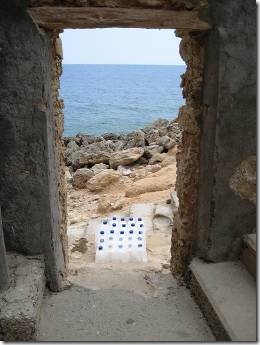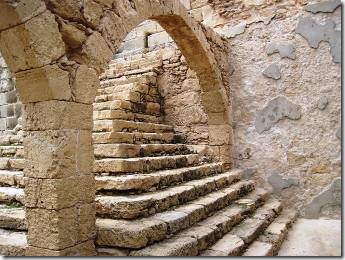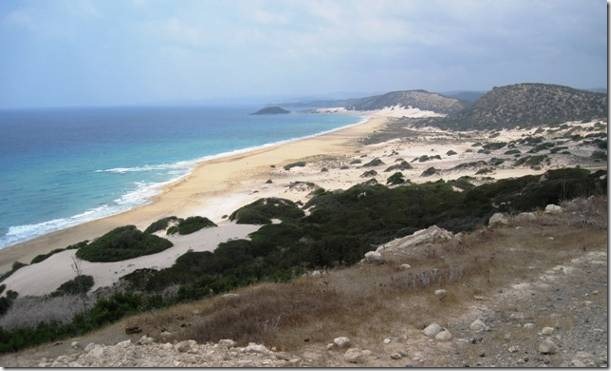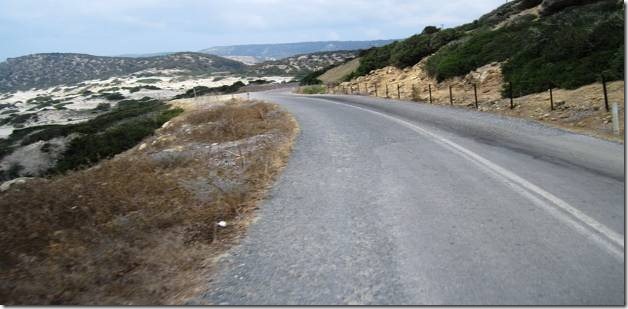Karpaz, Karpas, Karpasia….all the same. Lots of names for places here. Some the former Greek names, some the new Turkish names and some variations on both. This is part one of the day trip we did from the marina to the very tip of the peninsula.
Ru
ps I’m hoping the Sox don’t have their usual terrible August….
Karpaz Peninsula and the Apostolos Andreas Monastery
Yeni Erenkoy = red line and dot Dipkarpaz = red square Apostolos Andreas Monastery = red circle
“One of the most unspoiled areas on Cyprus is the Karpasia Peninsula, the outline of which stretches northeastwards, with its tip pointing directly to the border between Turkey and Syria.
http://www.tccruraldevelopment.eu/rdst/images/docs/ldskarpaz.pdf is a 180 page pdf document detailing suggested development plans for the area. It describes what is; good and bad, and what needed to be done to develop the area in a sustainable way.
Sheep and a few donkeys
Land is used for agriculture and grazing. We saw herds of sheep and multicolored goat! Some were beautiful brown and white, or black and white and different shades and patterns. This end of the peninsular is a wildlife refuge home to wild donkeys but these look to be domesticated belonging to whomever owns the sheep. We did see two donkeys begging for food from a car but drove around them before I could take a photo. They were bigger than we were so trying to pat them might not have been a good idea. I wish I’d gotten a photo.
We followed the coastline all the way to the very tip; about 50 kilometers (30 miles) from the marina.
We left the marina at 10:10 Friday morning but got a bit lost going through the small town of Dipkarpaz and had to back track, but returned there later in the day for a great lunch! Part of the time the road was well paved and half the time it was just paved and the final three miles was dirt. So we weren’t going very fast. We got to the tip about 11:50.
The tip…Zafer Burnu or Cape Apostolos Andreas
“ Zafer Burnu, also known as cape Apostolos Andreas, is approximately 5km along a reasonably smooth dirt track from the Apostolos Andreas Monastery. Along this part of the panhandle, the north and south coasts gradually merge, although because of geography and vegetation, you’ll only see the southern coast till you get to the end of the cape.
The Klidhes Islets
From here, all that can be seen are a series of small islands called the Klidhes Islets, unoccupied apart from seabirds and the occasional visiting scuba divers. If you could see far enough from here, the next landfall would be close to the border of Turkey and Syria.
This area was the site of the Neolithic city of Kastros. There was once a temple dedicated to Aphrodite here, but that disappeared many centuries ago. Kastros was excavated between 1970 and ’73 by a French team. They discovered that the settlement consisted of small, round, houses, with a diameter of less than 3m. Some of them were round a common courtyard, and some built into platforms in the hillside.
Findings on the site would suggest that the inhabitants were engaged in both fishing and farming. Radio carbon dating off some of the finds indicate the settlement being in use around 6000BC.
Sadly in 2005, the Turkish military decided there was a need for two large flagpoles on the site. In order to do this, they either covered or destroyed the ancient site (There are no records of what the ratio is). It is believed that there is still much to be rediscovered, but sadly this will not be for some time.”
http://www.whatson-northcyprus.com/interest/dipkarpaz/kastros.htm
Don’t fall !
On the other side crystal clear water.
Just the flags….
Apostolos Andreas Monastery
I was really disappointed. When I was about 10 we did a family trip to Canada, mostly Quebec. My mother especially wanted to see the Chateau Frontenac. Her comment on arriving there was…”This is it?” That’s how I felt. No signs, no brochures, no access to what is supposed to be the most important chapel, or if there was access, no one knew. Lots of tacky stands selling nothing connected to Saint Andrew that I could tell. I actually would have bought something since Andrew is the patron saint of sailors and travelers. I have no photo of the structure since it was so uninspiring and neglected. Actually if it were totally neglected and left on its own with no souvenir sellers or beer concessions or newly constructed outbuildings, that would have been better. You could have imagined. But this was worse than total neglect; it was ruined be a lack of imagination. While doing my “after the visit” research I came across this article….
You’ve Let Birthplace Of Christianly Go To Ruin: posted on Monday, March 29th, 2010 http://www.cyprusq.com/archbishop-chrysostomos-visited-apostolos-andreas-monastery/
Controversial cleric Archbishop Chrysostomos has blamed the Greek Cypriots for the failure to keep the birthplace of Christianity on the island well maintained.
He crossed the border to see firsthand the state of Apostolos Andreas Monastery, on the tip of the Karpaz peninsula, on Monday. It was the first time a leader of the Greek Cypriot Orthodox Church had visited North Cyprus since July 20,1974
And Archbishop Chrysostomos, normally a bitter critic of Turkey and the TRNC {Turkish Republic of North Cyprus} , was diplomatic in the extreme, talking of his desire to meet TRNC Prime Minister Dervis Eroglu and also to meet with Turkish Prime Minister Recep Tayyip Erdogan when he visits Ankara next month.
While he said the main purpose of his trip was to press forward with the scheme to renovate and restore the historic monastery, Archbishop Chrysostomos changed his tune from heaping all the blame on Turkey and TRNC.
He said that “certain quarters in the South” were also responsible for the delays that have brought the monastery to the verge of collapse.
While a current restoration scheme is ready to start within weeks, previous initiatives to save the building have fallen through.
“It was through our own fault that Apostolos Andreas has not been maintained to this day,” he said.” I used to tell them , `look, the monastery must be maintained because in the end it will cave in.` So my conscience is easy, as I have done my duty to the fullest. “God willing, very soon we shall see the start of restoration work, something that is in the interests both of Turkey, as being a democratic country, and of the Turkish Cypriots in that they will show they have great love for these monuments.”
He added that Cyprus was “ a small state that is on friendly terms with Turkey, the European Union and Middle East because our region desires peace and we must all work to this goal”.
Archbishop Chrysostomos had written a letter to Mr Erdogan calling for work to begin as soon as possible . Mr Erdogan replied, saying he would do what he could.
It is the refusal of stallholders to move that is holding up the start of restoration work, agreed by both Cypriot leaders.
President Mehmet Ali Talat has personally gone to speak to the stallholders on several occasions recently.
I think this is the oldest part of the complex….
“An enormous modern plaza of pilgrims lodgings frames the slightly older monastery buildings wrapped around the church. Below, the modern church steps lead down to a square, vaulted chapel, three baptismal basins fed by a sacred spring and an old wharf.” www.cypnet.co.uk/…/karpas/apandreas/index.html
The modern church….
Apostolos Andreas Saint Andrew
“The monastery is dedicated to Saint Andrew (Apostle Andreas). According to the holy books, he was the first person to be called for induction to priesthood by Jesus Christ, His title was O Protoklitos meaning: ‘the one first called."
The monastery is one of the pilgrimage centres of the Cypriot Orthodox Church. It was once known as ‘the Lourdes of Cyprus’, served not by an organized community of monks but by a changing group of volunteer priests and laymen.
An enormous modern plaza of pilgrims’ lodgings frames the slightly older monastery buildings wrapped around the central church. Below, the modern church steps lead down to a square, vaulted chapel, three baptismal basins fed by a sacred spring and an old wharf. It was on this site that it was said St. Andrew briefly landed in Cyprus on his final missionary journey back to his Palestinian homeland. His footfall revealed a spring whose waters miraculously healed the blind captain of his ship.
On the bust in the courtyard of the monastery is an inscription stating that the monastery was built by Ionnis Oicoromus.
A fortified monastery stood here in the 12th century, from which Isaac Comnenus negotiated his surrender to Richard the Lionheart, though the chapel built in the 15th century is the oldest surviving building. http://www.360cities.net/image/apostolos-andreas-monastery-karpaz-cyprus#331.80,-11.40,70.0
Greek Orthodox Icons, most likely not old.
The “Baba”
I must have been staring at the priest because one of the men explained to me that he was the “baba” which I knew meant father…He would certainly make a great Santa Claus.
The most interesting view of the complex taken from the water side.
This is what I saw below the church…
According to the 1999 Nelles Cyprus Guide
“The monastery was built in the year 1867, but of greater interest is the quaint little 15th century vaulted Gothic chapel below on the rocky shore” The guide goes on to describe the artifacts within but we saw none of those either. There were no signs anywhere and no internet photos of anything other than what we saw… I told Randal we have to go back and double check.
Our return trip gave us beautiful panoramas.
The paved road through the National Park.
It was after 1pm so time to go find some lunch. We headed back to the town of Dipkarpaz…next email.

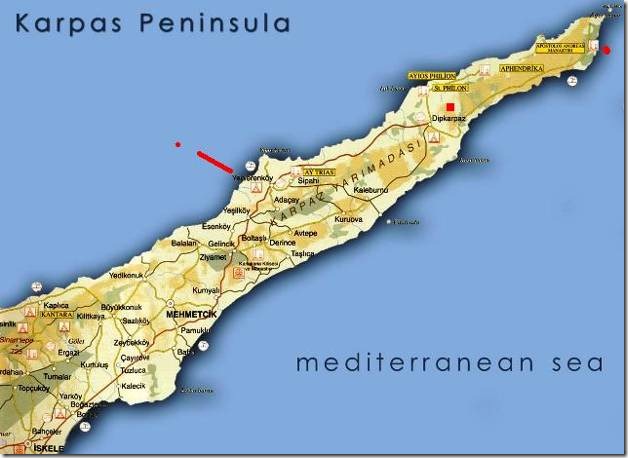
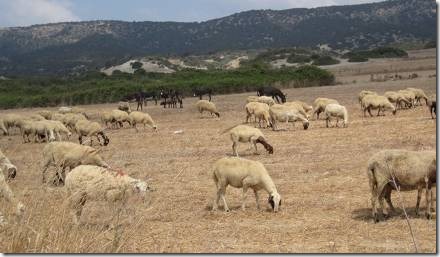
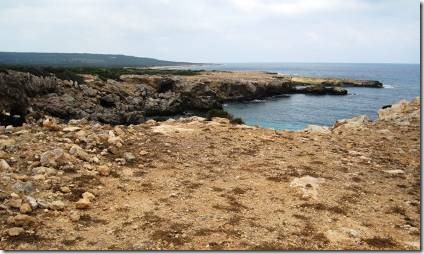
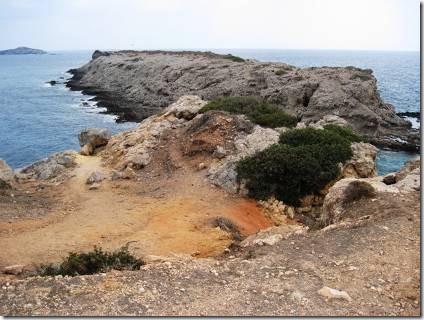
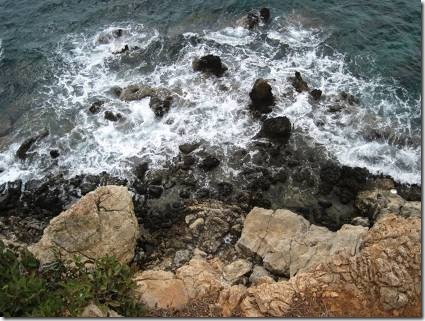
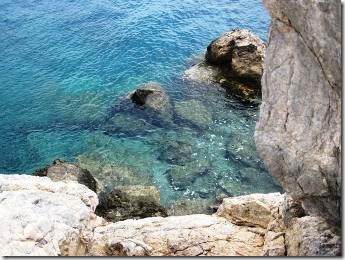
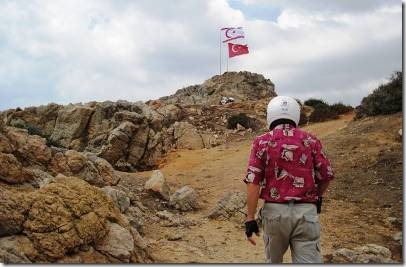
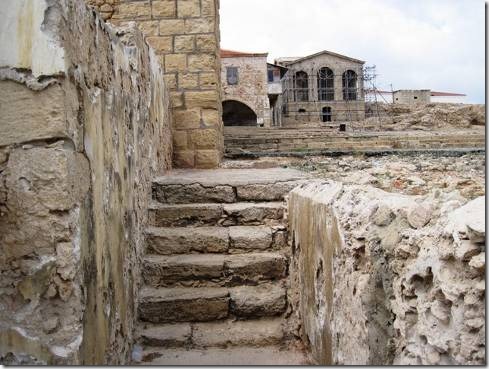
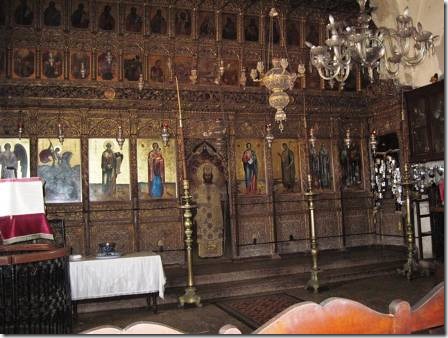
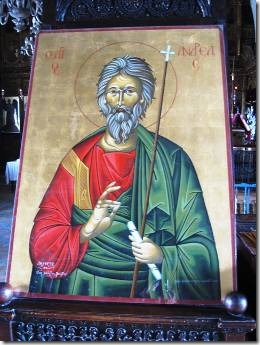
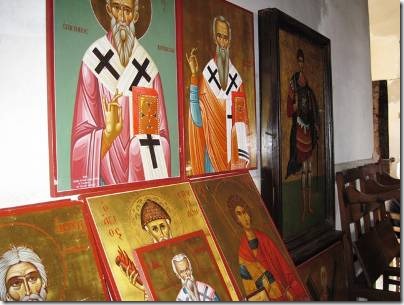
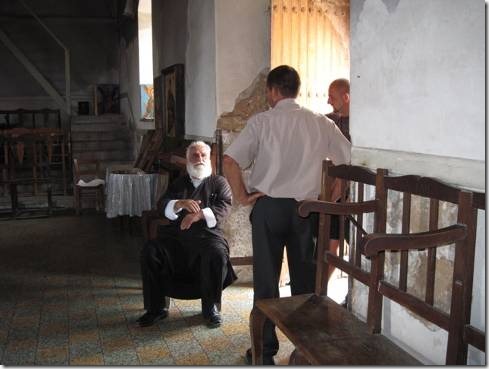
![clip_image008[1] clip_image008[1]](http://www.mydoramac.com/wordpress/wp-content/uploads/2011/08/clip-image0081-thumb.jpg)
